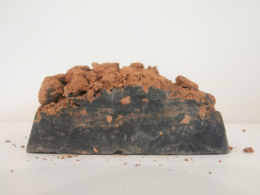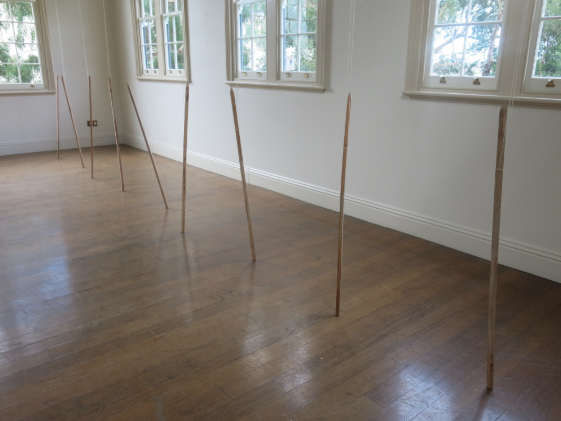residue : the schoolhouse gallery
written for Residue: Ally McKay and Tess Mehonoshen
This reflection is written in lutruwita/Tasmania. The writer acknowledges the muwinina and palawa people of nipaluna/Hobart as the traditional custodians of the land, and offers her respect to elders past, present and emerging.
![]()
Decay Block II, 2018, Tess Mehonoshen, Cement, iron-oxide and clay sculpture
On the low veranda of the Schoolhouse Gallery, horizontally stacked and leaning against a supporting column, you are met with the first work. Tess Mehonoshen’s material installation of fabric, cement, sourced clay and iron oxide are folded together in a row. They seem such delicate objects, like pillowslips turned to ash in a house fire. While left undisturbed, they hold their shape, but you think even a sigh might disperse them into the wind. The objects on the veranda however must be more robust than they seem, if they are to survive the Tasmanian winter outdoors.
Walking through the first doorway takes you into the foyer of the Schoolhouse, where the same material from the veranda obstructs the doorway inside, forcing you back outside, and through another door to access the other half of the show. Looking over Mehonoshen’s Door Blockade there is a sparse layering of objects in each of the rooms beyond. The view through one door frames another work, an installation of wooden stakes and string, cross-hatching horizontal lines with vertical. The doorway in this room frames the work in the next.
This neatness is mirrored in every room of the Schoolhouse, the objects seemingly taking their cues from each other, and from the space, but between each there is room to breathe. The gallery space was treated with a lightness of touch, and a subtlety necessary for heavy themes.
Loss and residue.
Hold. Ally McKay installs an intricate web of string that supports nails hanging from the wall. It is unclear which material is supporting the other. The string or the nails. There is a tension here between stillness and vibration. The materials move in themselves, the string trembles as visitors disturb the space, the light from a nearby window moves the shadows of nails across the wall. Mehonoshen’s Decay Blocks crumble on a shelf. Dust, already gathered.
![]()
Fireplace I, 2018, Tess Mehonoshen, cement, iron-oxide, clay & fabric installation.
The emptiness of the fireplaces in the Schoolhouse is further articulated by Mehonoshen’s filling them with her fabric, cement, sourced clay and iron oxide installations. There is a feeling as though something tragic has happened, not here, but somewhere distant. The objects themselves speak heavily of the place they came from. Relics brought back and left here, part shrine, part castaway. The gallery is itself a replica of a colonial schoolhouse, originally built at Osterley in central Tasmania in 1890, a long way away from where it now lives inside the walls of Rosny Farm. As with the objects inside, the building belongs, and it doesn’t belong.
It is so important to talk about place in this context, in Tasmania, in a replica colonial schoolhouse on Hobart’s eastern shore, in an exhibition of works by two Brisbane artists. This conversation is heavy with echoes of residue and loss, both personal, in the voices of the two artists, and the loss that is ingrained in these kinds of places.
![]()
Still Standing 2018, Ally McKay, Installation, wooden stakes and string.
A row of wooden stakes stand upright, loosely tied to the ceiling with string. Someone’s child runs from one side of the room to the other, weaving in between the string and wooden stake installation. They each waver and right themselves. Ally McKay’s Standing is a poetic installation of materials rarely associated with the quiet beauty they convey here. Objects sometimes used for gardening, sometimes used for violence, sometimes used for poetry.
Thinking again about materials, the whole gallery space is sparsely furnished with objects that can also be used to repair other objects (and sometimes also plants and people). Wooden stakes, fabric, string, nails, cement and wire. Here in the Schoolhouse Gallery, they exist in and of themselves, creating and supporting only each other. Though in us, they prompt the knowledge that what is broken is not always past, that support can manifest in the smallest, and most surprising places, and all of our hope for the future breathes through the residue of things.
written for Residue: Ally McKay and Tess Mehonoshen
This reflection is written in lutruwita/Tasmania. The writer acknowledges the muwinina and palawa people of nipaluna/Hobart as the traditional custodians of the land, and offers her respect to elders past, present and emerging.

Decay Block II, 2018, Tess Mehonoshen, Cement, iron-oxide and clay sculpture
On the low veranda of the Schoolhouse Gallery, horizontally stacked and leaning against a supporting column, you are met with the first work. Tess Mehonoshen’s material installation of fabric, cement, sourced clay and iron oxide are folded together in a row. They seem such delicate objects, like pillowslips turned to ash in a house fire. While left undisturbed, they hold their shape, but you think even a sigh might disperse them into the wind. The objects on the veranda however must be more robust than they seem, if they are to survive the Tasmanian winter outdoors.
Walking through the first doorway takes you into the foyer of the Schoolhouse, where the same material from the veranda obstructs the doorway inside, forcing you back outside, and through another door to access the other half of the show. Looking over Mehonoshen’s Door Blockade there is a sparse layering of objects in each of the rooms beyond. The view through one door frames another work, an installation of wooden stakes and string, cross-hatching horizontal lines with vertical. The doorway in this room frames the work in the next.
This neatness is mirrored in every room of the Schoolhouse, the objects seemingly taking their cues from each other, and from the space, but between each there is room to breathe. The gallery space was treated with a lightness of touch, and a subtlety necessary for heavy themes.
Loss and residue.
Hold. Ally McKay installs an intricate web of string that supports nails hanging from the wall. It is unclear which material is supporting the other. The string or the nails. There is a tension here between stillness and vibration. The materials move in themselves, the string trembles as visitors disturb the space, the light from a nearby window moves the shadows of nails across the wall. Mehonoshen’s Decay Blocks crumble on a shelf. Dust, already gathered.

Fireplace I, 2018, Tess Mehonoshen, cement, iron-oxide, clay & fabric installation.
The emptiness of the fireplaces in the Schoolhouse is further articulated by Mehonoshen’s filling them with her fabric, cement, sourced clay and iron oxide installations. There is a feeling as though something tragic has happened, not here, but somewhere distant. The objects themselves speak heavily of the place they came from. Relics brought back and left here, part shrine, part castaway. The gallery is itself a replica of a colonial schoolhouse, originally built at Osterley in central Tasmania in 1890, a long way away from where it now lives inside the walls of Rosny Farm. As with the objects inside, the building belongs, and it doesn’t belong.
It is so important to talk about place in this context, in Tasmania, in a replica colonial schoolhouse on Hobart’s eastern shore, in an exhibition of works by two Brisbane artists. This conversation is heavy with echoes of residue and loss, both personal, in the voices of the two artists, and the loss that is ingrained in these kinds of places.

Still Standing 2018, Ally McKay, Installation, wooden stakes and string.
A row of wooden stakes stand upright, loosely tied to the ceiling with string. Someone’s child runs from one side of the room to the other, weaving in between the string and wooden stake installation. They each waver and right themselves. Ally McKay’s Standing is a poetic installation of materials rarely associated with the quiet beauty they convey here. Objects sometimes used for gardening, sometimes used for violence, sometimes used for poetry.
Thinking again about materials, the whole gallery space is sparsely furnished with objects that can also be used to repair other objects (and sometimes also plants and people). Wooden stakes, fabric, string, nails, cement and wire. Here in the Schoolhouse Gallery, they exist in and of themselves, creating and supporting only each other. Though in us, they prompt the knowledge that what is broken is not always past, that support can manifest in the smallest, and most surprising places, and all of our hope for the future breathes through the residue of things.